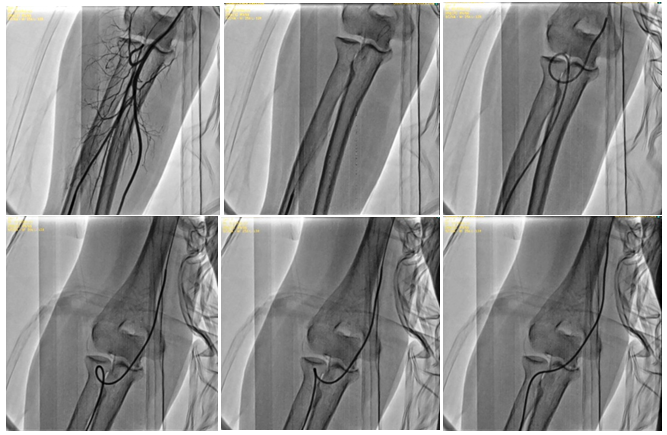Journal of
eISSN: 2373-4396


Transradial approach (TRA) today becomes a golden standard for percutaneous coronary interventions worldwide. TRA is generally associated with certain learning curve and sometimes radial artery anomalies (RAA) can be important cause of TRA failure. RAA include high bifurcating origin of the radial artery (high take-off radial artery), radial artery loop, tortuosity, hypoplasia and stenosis. In most cases, these anomalies can be overcome by using hydrophilic guiding wire and diagnostic 5F Judkins right catheter, sometimes 0,014” hydrophilic coronary wire. RAA are not uncommon in general population. In most cases they can be easily traversed with thoroughly selected steps and material especially by dedicated radial operators in high-volume TRA center, but sometimes they can be a reason for procedural failure.
Keywords: Transradial approach; Radial artery anomalies; Percutaenous coronary interventions
TRA: Transrardial Approach; TUA: Transulnar Approach; RAA: Radial Artery Anomalies; CA: Coronary Angiography; PCI: Percutaneous Coronary Interventions
Transradial approach (TRA) today becomes a golden standard for percutaneous coronary interventions worldwide. Its advantages over the transfemoral approach (TFA) are clear and include reduced risk of access-site complications (bleeding), early patient ambulation, better patient comfort, reduced costs for hospitalization and possibility for same day discharge [1-5]. On the other side, TRA can be very challenging in comparison to TFA demanding better operators` skills, especially in cases of different anatomical variations and anomalies of the forearm`s vasculature.
TRA is generally associated with certain learning curve and sometimes radial artery anomalies (RAA) can be important cause of TRA failure [1,3]. Since RAA may significantly prolong and diminish the success of coronary angiography (CA) and percutaneous coronary intervention (PCI), we strongly recommend performing pre-procedural retrograde angiography of the forearm (radial artery angiography) as a routine procedure in every single patient [5]. This step will help the operator to evaluate individual radial artery anatomy and its anomalies far better as well as to plan a quick strategy to overcome them, thus preventing unnecessary and possible radial artery damage (dissection, rupture etc.) and procedure prolongation [6].
RAA are relatively common in general population, although there are limited data concerning this issue worldwide [4]. Their incidence may vary according to the available literature, starting from 8,8% [7,6], 13,8% [2], up to 22,8% according to Valsecchi et al. [3]. They can be reason for procedural failure in 1-5% of the patients even in experienced operators` hands [4,9]. RAA include high bifurcating origin of the radial artery (high take-off radial artery) (Figure 1), radial artery loop (Figure 2 & 3), tortuosity (Figure 1), hypoplasia and stenosis. In most cases, these anomalies can be overcome by using hydrophilic guiding wire and diagnostic 5F Judkins right catheter (JR 4) or even 4F Judkins right catheter, sometimes 0,014” hydrophilic coronary wire [1] and in rare cases by using so-called BAT technique (“balloon-assisted tracking”), a technique proposed by Dr. Tejas Patel et al. [9]. Operators should be experienced in TRA and by using some simple maneuvers like push-and-pull technique and catheter rotation usually achieve a successful negotiation with the radial artery (Figure 4).

Nevertheless, if sometimes CA and PCI via TRA cannot be performed due to severe pain, spasm or any other reason, we recommend use of ipsilateral ulnar artery (ipsilateral transulnar approach, TUA) or contralateral (left) TRA as an alternative route. According to a Macedonian Registry of 19 292 patients who underwent CA and/or PCI in the period from March 2011 to December 2014, RAA were found in 1625 patients (8,8%) from which high bifurcation origin of the radial artery (high take-off radial artery) was the most common anomaly present in 1017 patients (5,5%). Second most common RAA was radial artery tortuosity found in 227 patients (1,2%) and third was radial artery loop accounting 176 patients (0,95%) [1].
RAA are not uncommon in general population. In most cases they can be easily traversed with thoroughly selected steps and material especially by dedicated radial operators in high-volume TRA center, but sometimes they can be a reason for procedural failure. Technical difficulties can be solved by proper TRA training since their successful overcoming is associated with certain learning curve. Routine pre-procedural retrograde radial artery angiography remains crucial step prior to CA/PCI for every radial operator.

© . This is an open access article distributed under the terms of the, which permits unrestricted use, distribution, and build upon your work non-commercially.